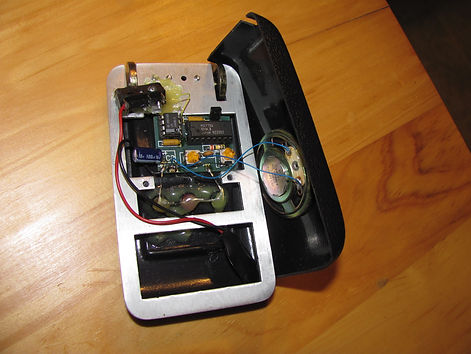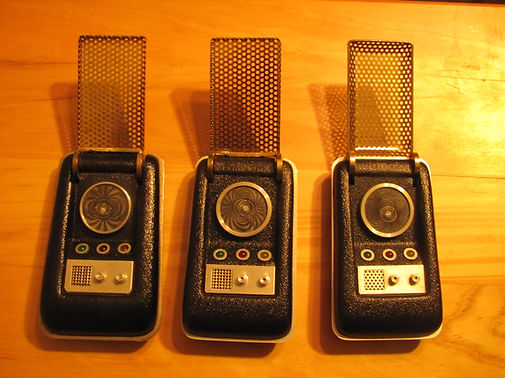
The Copycats - Star Trek TOS
Prop Replica Reference Guide
C. Roadhouse
Years in operation: 1986 - 1998 (approximate)
Items Sold
Communicators
Tricorders
Phaser I hand units
Production numbers: unknown
Another one-man operation that basically sold to dealers and mail order houses for retail sale. One major purchaser was New Eye Studios, which was apparently his main customer. A very experienced machinist and craftsman.
Communicators
Version 1: These were made for about 2 years. Very large, heavy, & wide unit, made of haircell plastic with a considerably thick metal midplate. Shape and dimensions considerably incorrect from all other replica makers. Grid was brass plated heavy steel, and welded to hinge wheels with no corresponding wire surrounding same. Aluminum moiré disc, control plate, and knobs which were threaded and screwed in from behind, which also secured the control plate with that feature. Has flashing LEDs and analog beeping chirp. Works from 9 volt battery. Considered by most collectors as the least desirable and most inaccurate replica made of the prop, aside of perhaps Marco's piece.
Version 1



Analog beep and blinking LEDs only.
Version 2



This unit comes with digital chirp, blinking LEDs, and Scotty voice. Reworked & improved body, same heavy steel grid, with no surrounding wire.
Version 3 - Final Revision



This final run incorporates the best quality from this manufacturer, notably the improved and corrected grid. These units also came with either Spock or Scotty Voice, as well as both voices in one unit. This example however, has only analog beep and blinking LEDs.
All three versions side-by-side.

Hand Phaser
Resin hand phaser unit consisting of aluminum thumbwheel, metal aspirator pile, acrylic meter, blue jewel indicator light, and aluminum side strips. Under black tape top “trigger” (which we now have known for years was NEVER the trigger) were 2 separate key switches that activated digital sound and a bi-colored LED: Left key lit green color, right key activated red LED color, with digital phaser sound. Very nicely made and functional unit. Very few of these particular units surface for sale.




Tricorders
Haircell plastic and all correct machined and stamped aluminum accessories. Smaller and squarer in shape and size than Starfleet Command's, or HMS units, but certainly larger than Starfleet Fabrication's effort. A bit closer in design to Marco's tricorder, however of much better quality, materials, and construction. He used his machinists skills to make improvements that the other manufacturers could have learned from. His faceplate was not glued on as most previous makers units. It was made from a longer rectangle of aluminum, and bent on both sides and fit within the plastic hood, with corresponding pivot holes to line up with the holes in the aluminum side panels and holes in the plastic hood with which he placed the studs for the hood to swing up and down. VERY nice innovation, and unnoticeable from the assembled unit. All other parts mechanically installed with screws. The only drawback is it came with a nylon strap. This unit is a fine example, if not one of the best examples of engineering of the tricorder from a one man manufacturer to date.
2 versions:
Version 1: with flashing LEDs and analog tricorder sound, grey screen. Works off 9 volt battery.
Version 2: same as above, but later units had various “holographic images” for the monitor screen.





